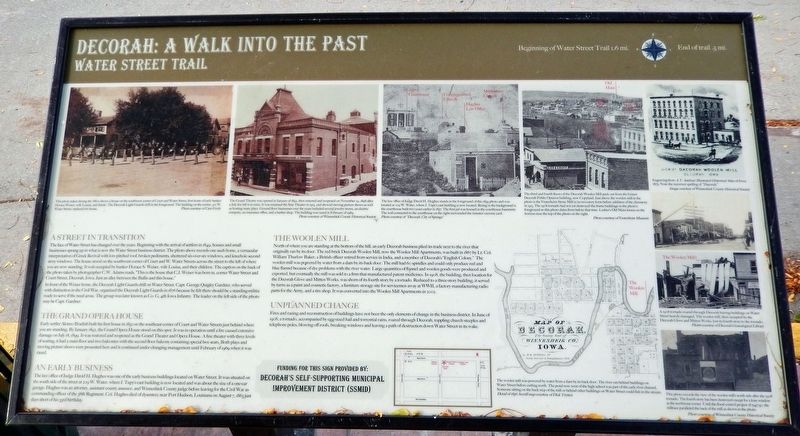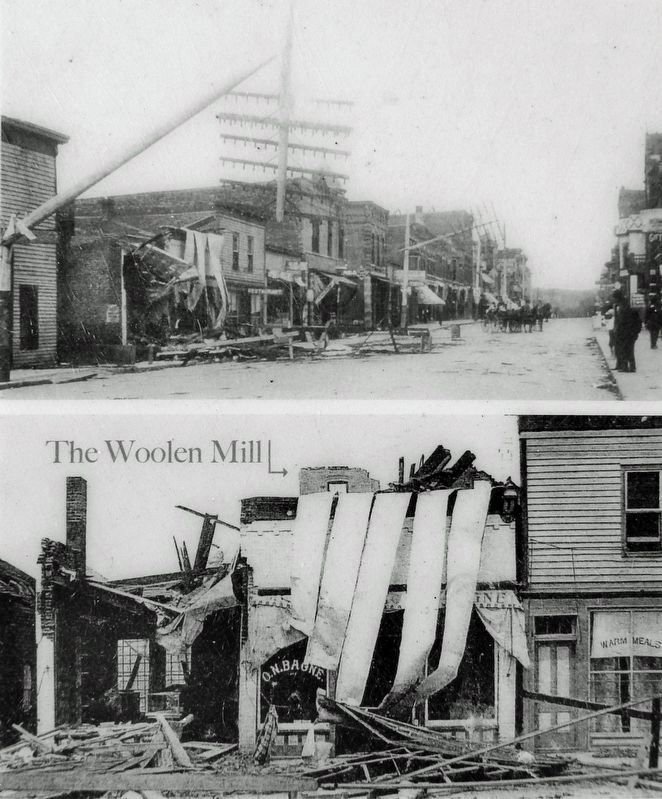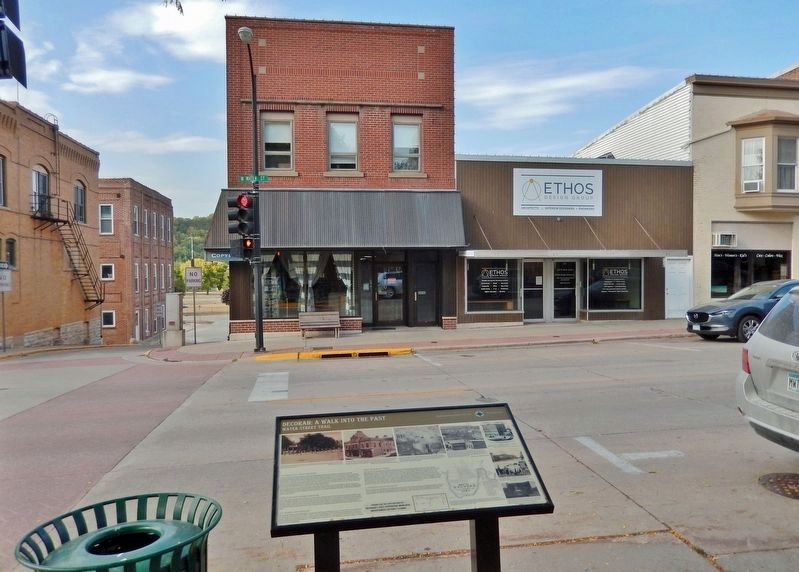Decorah in Winneshiek County, Iowa — The American Midwest (Upper Plains)
Decorah: A Walk into the Past
Water Street Trail
A Street in Transition
The face of Water Street has changed over the years. Beginning with the arrival of settlers in 1849, houses and small businesses sprang up in what is now the Water Street business district. The photo above records one such home, a vernacular interpretation of Greek Revival with low-pitched roof, broken pediments, shuttered six-over-six windows, and kneehole second story windows. The house stood on the southwest corner of Court and W. Water Streets across the street to the left of where you are now standing. It was occupied by banker Horace S. Weiser, wife Louisa, and their children. The caption on the back of the photo taken by photographer C.W. Adams reads, “This is the house that C.J. Weiser was born in, corner Water Street and Court Street, Decorah, Iowa. Just an alley between the Bullis and this house.”
In front of the Weiser home, the Decorah Light Guards drill on Water Street. Capt. George Quigley Gardner, who served with distinction in the Civil War, organized the Decorah Light Guards in 1876 because he felt there should be a standing militia ready to serve if the need arose. The group was later known as Co. G, 4th Iowa Infantry. The leader on the left side of the photo may be Capt. Gardner.
The Grand Opera House
Early settler Alonzo Bradish built his first house in 1852 on the southeast corner of Court and Water Streets just behind where you are standing. By January 1892, the Grand Opera House stood on this spot. It was in operation until a fire caused extensive damage on July 18, 1899. It was restored and reopened as the Grand Theater and Opera House. A fine theater with three levels of seating, it had a main floor and two balconies with the second floor balcony containing special box seats. Both plays and moving picture shows were presented here and it continued under changing management until February of 1969 when it was razed.
An Early Business
The law office of Judge David H. Hughes was one of the early business buildings located on Water Street. It was situated on the south side of the street at 209 W. Water, where J. Tupy's east building is now located and was about the size of a one-car garage. Hughes was an attorney, assistant county assessor, and Winneshiek County judge before leaving for the Civil War as commanding officer of the 38th Regiment. Col. Hughes died of dysentery near Port Hudson, Louisiana on August 7, 1863 just days short of his 33rd birthday.
The Woolen Mill
North of where you are standing at the bottom of the hill, an early Decorah business plied its trade next to the river that originally ran by its door. The red brick Decorah Woolen Mill,
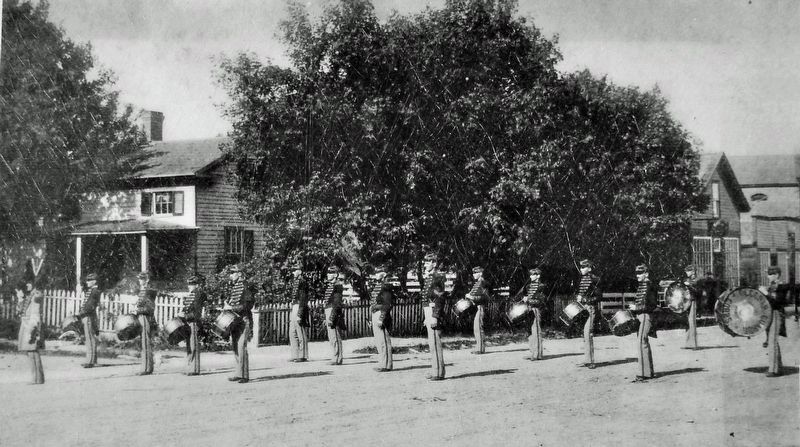
Courtesy of Cam Forde
2. Marker detail: Decorah Light Guards
This photo taken during the 1880s shows a house on the southwest corner of Court and Water Street, first home of early banker Horace Weiser, wife Louisa, and family. The Decorah Light Guards drill in the foreground. The building on the corner, 301 W. Water Street, replaced the house.
Unplanned Change
Fires and razing and reconstruction of buildings have not been the only elements of change in the business district. In June of 1908, a tornado, accompanied by egg-sized hail and torrential rains, roared through Decorah, toppling church steeples and telephone poles, blowing off roofs, breaking windows and leaving a path of destruction down Water Street in its wake.
[other photo captions]
• Engraving from A. T. Andreas’ Illustrated
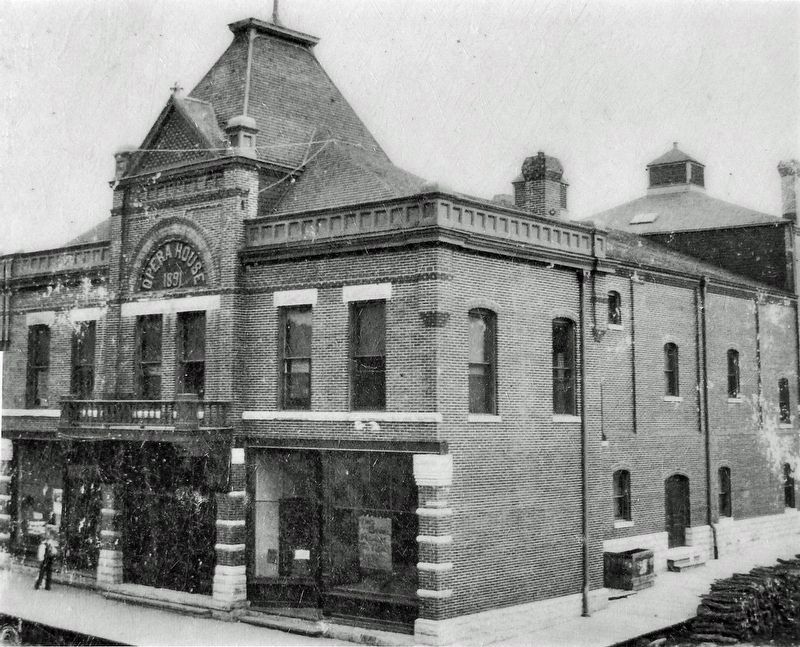
Winneshiek County Historical Society
3. Marker detail: The Grand Theatre
The Grand Theatre was opened in January of 1892, then restored and reopened on November 19, 1898 after a July fire left it in ruins. It was renamed the Star Theater in 1913, and showed moving picture shows as well as hosting many plays. Ground floor businesses over the years included several jewelry stores, an electric company, an insurance office, and a barber shop. The building was razed in February of 1969.
Funding for this sign provided by: Decorah’s Self-supporting Municipal Improvement District
Topics. This historical marker is listed in these topic lists: Architecture • Entertainment • Industry & Commerce • Settlements & Settlers.
Location. 43° 18.246′ N, 91° 47.296′ W. Marker is in Decorah, Iowa, in Winneshiek County. Marker is at the intersection of West Water Street and Court Street, on the left when traveling west on West Water Street. The marker is located along the sidewalk at the southeast corner of the intersection. Touch for map. Marker is at or near this postal address: 219 West Water Street, Decorah IA 52101, United States of America. Touch for directions.
Other nearby markers. At least 8 other markers are within walking distance of this marker. A different marker also named Decorah: A Walk into the Past (about 300 feet away, measured in a direct line); a different marker also named Decorah: A Walk into the Past (about 300 feet away); a different marker also named Decorah: A Walk into the Past (about 300 feet away); a different marker also named Decorah: A Walk into the Past (about 300 feet away); Replica of the Statue of Liberty (about 400 feet away); "The Biggest Day in the History of the County"
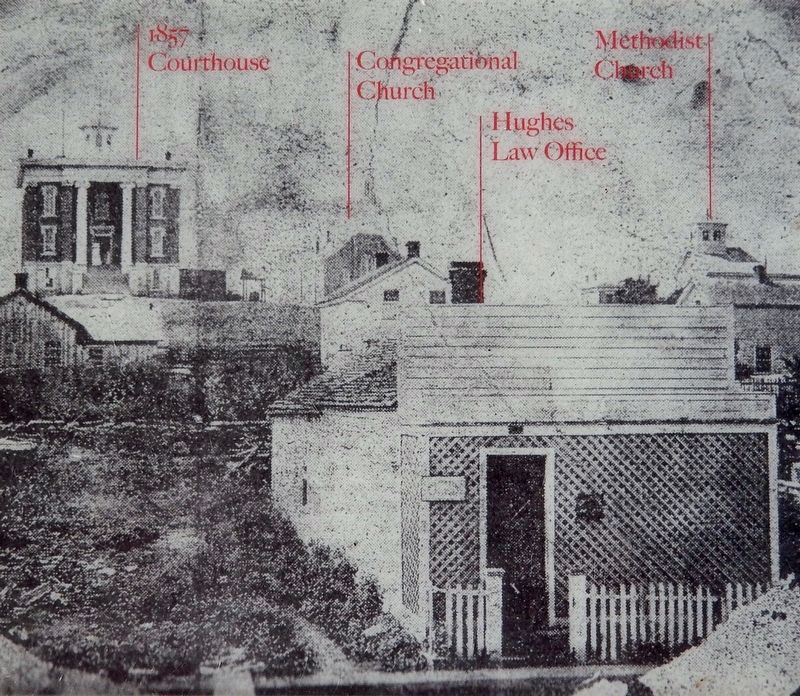
Courtesy “Decorah: City of Springs”
4. Marker detail: Hughes Law Office, 1859
The law office of Judge David H. Hughes stands in the foreground of this 1859 photo and was located at 209 W. Water, where J. Tupy's east building is now located. Rising in the background is the courthouse built two years earlier in 1857. The first jail was housed in the courthouse basement. The wall connected to the courthouse on the right surrounded the inmates' exercise yard.
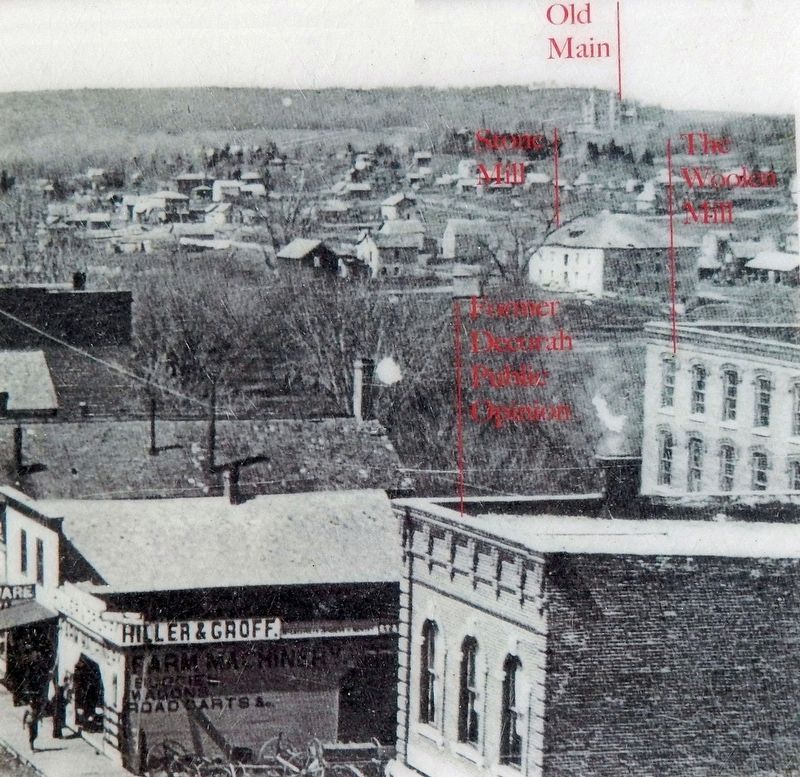
Courtesy Vesterheim Museum
5. Marker detail: Decorah Woolen Mill
The third and fourth floors of the Decorah Woolen Mill peek out from the former Decorah Public Opinion building, now Copyland. Just above the woolen mill in the photo is the Vesterheim Stone Mill in its two-story form before addition of the clerestory in 1913. The 1908 tornado had not yet destroyed the frame buildings in the photo's foreground so this photo dates from before that time. Luther's Old Main looms on the horizon near the top of the photo on the right.
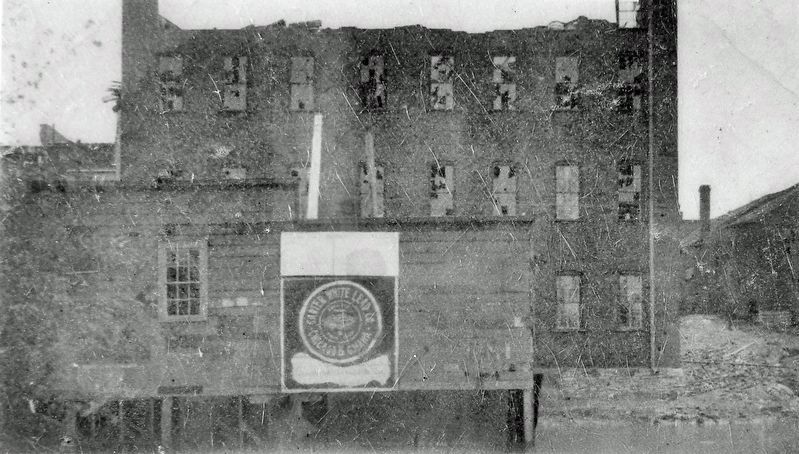
Winneshiek County Historical Society
7. Marker detail: 1908 Tornado Damage
This photo records the view of the woolen mill's north side after the 1908 tornado. The fourth story has been destroyed except for a lone window at the northwest corner. Until the flood control project of 1947-50, the millrace paralleled the back of the mill as shown in the photo.
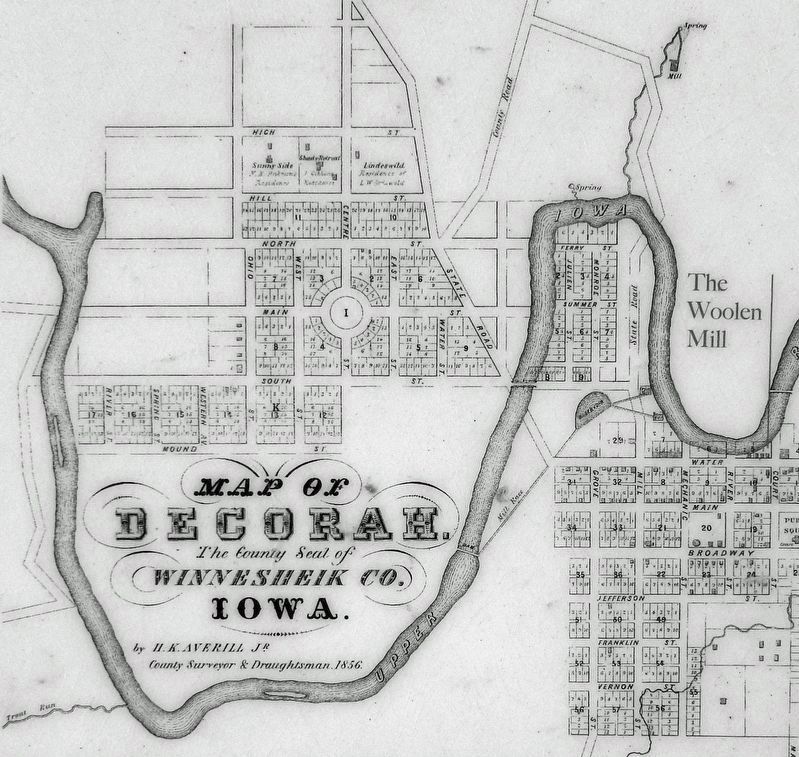
Courtesy Dick Trytten
8. Marker detail: 1856 Averill Map
The woolen mill was powered by water from a dam by its back door. The river ran behind buildings on Water Street before cutting north. The pond now west of the high school was part of the early river channel. Someone sitting on the back step of the mill or behind other buildings on Water Street could fish in the stream.
Credits. This page was last revised on February 21, 2024. It was originally submitted on February 21, 2024, by Cosmos Mariner of Cape Canaveral, Florida. This page has been viewed 68 times since then. Photos: 1, 2, 3, 4, 5, 6, 7, 8, 9. submitted on February 21, 2024, by Cosmos Mariner of Cape Canaveral, Florida.
